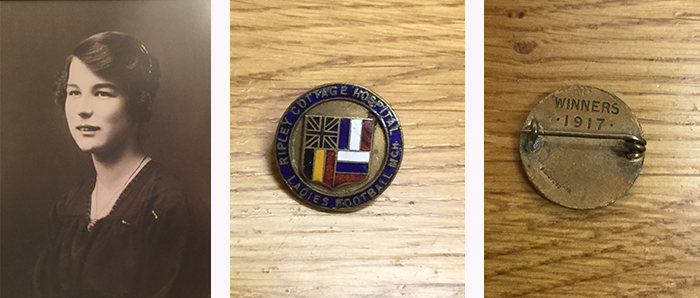Memorabilia Corner: A Medal from Women's Football in World War One
21/03/2018 - 2.47
Ian Nannestad
 I was recently contacted by a reader of my website, Jackie Day, with images of a pin badge from 1917. The badge is circular in shape with a blue outer circle within which is written: “RIPLEY COTTAGE HOSPITAL LADIES FOOTBALL MCH”. The centre of the badge has a shield within which there are the flags of the United Kingdom, France, Imperial Russia and Belgium. These comprised the four main Allied nations for most of the war; it was not until April 1917 that the United States entered the conflict. The reverse shows the year ‘WINNERS. 1917’ and the name of the manufacturer, which is partly indecipherable. However, from the remaining text which reads “… & Sons. Bradford” suggests this was probably manufactured by Messrs Fattorini and Sons of Bradford, well known as manufacturers of football prizes and, of course, the trophy presented to the FA Cup winners from 1911 until around 2012 when it was ‘retired’.
I was recently contacted by a reader of my website, Jackie Day, with images of a pin badge from 1917. The badge is circular in shape with a blue outer circle within which is written: “RIPLEY COTTAGE HOSPITAL LADIES FOOTBALL MCH”. The centre of the badge has a shield within which there are the flags of the United Kingdom, France, Imperial Russia and Belgium. These comprised the four main Allied nations for most of the war; it was not until April 1917 that the United States entered the conflict. The reverse shows the year ‘WINNERS. 1917’ and the name of the manufacturer, which is partly indecipherable. However, from the remaining text which reads “… & Sons. Bradford” suggests this was probably manufactured by Messrs Fattorini and Sons of Bradford, well known as manufacturers of football prizes and, of course, the trophy presented to the FA Cup winners from 1911 until around 2012 when it was ‘retired’.
In addition to the images of the badge, Jackie was able to add that the badge belonged to her grandmother Mary Ellen Ludlum who was employed at Denby Pottery during World War One and who would have been 15 years old in 1917.
This led me to research within the British Newspaper Archive, which, very conveniently, includes copies of the Ripley and Heanor News for 1917.
The first article concerning women’s football appears in the edition for 29 June 1917: “With the advent of ladies into so many spheres not generally entered into by them prior to the war, football as played by the feminine gender shows signs of becoming very popular. The sports committee of Ripley Cottage Hospital have seized the novelty for their annual fixture on July 28th, when a match between ladies will be part of the programme. Mr L. Lawton has promised a team from Denby Pottery, and Mr. Caffery from Messrs. Gee and Sons’ munition works. The fair munitioneers have been at practice on the Town Ground this week.”
The sports were held at the local Butterley Cricket Club ground on Saturday 26 July. The report of the day’s proceedings states that a record crowd was in attendance and that the ladies’ football match was “undoubtedly the most keenly anticipated event of the afternoon, and was an enjoyable novelty.”
The teams are listed as follows:
Messrs. Gees: Misses F Brown; N Holmes, E Davenport; F Hall, P Ottewell, M Daley; G Holmes, F Cupit, D Hall, R Hunt, E Brown
Denby Pottery: Misses Miriam Stapleton; Elsie Bamford, Frances Neale; M Ellen Neale, Nellie Bridgewater, Elsie May Bamford; Elsie M Strange (captain), Winnie Rose, Hilda Gaunt, Florrie Cresswell, Margaret Belfield
The star player was Elsie Strange who scored a goal in each half to give Denby Pottery a 2-0 victory. The report in the Ripley and Heanor News notes that the referee carried out his task “with discretion and tact.”Although there is no Mary Ellen Ludlum in the line-up it appears she is ‘M Ellen Neale’; a match report refers to one of the Denby players being ‘Mary Ellen’ and Jackie Day’s conversations with her grandmother confirm that the medal was awarded to Mary Ellen Ludlum.

Picture caption: The badge awarded to Mary Ellen Ludlum of the Denby Pottery team, winners of the first match against Ripley Munition Works which took place at the Ripley Cottage Hospital Sports, July 2017 (Jackie Day)
Picture Credits – Jackie Day
The sports, which also included a schoolboys’ six-a-side contest and various athletic events, were not completed on the day consequently they were continued on the evening of Wednesday 15 August. The women’s football match was so popular that a second game was played between the two teams. This time a silver challenge cup provided by the hospital governors was on offer as a prize for the winners.
Over 1,000 turned out to watch the second match and there was something of a surprise when the munition workers turned the tables on their opponents registering a 3-2 win. Goalscorers for the winners were Maggie Daley 2 and Dolly Hall. There is no record of the Denby scorers. The factory proprietor, Mr Gee, announced that each member of the winning team would receive “a souvenir of value.” (Ripley and Heanor News, 17 August 1917)
Ripley Munition Girls’team played at least four further matches. The first of these was on 8 September 1917 at Somercotes sports when they defeated F Newhall’s Charity Girls 4-0 in an event to raise funds for the Disabled Soldiers’ and Sailors’ Fund. Then on 6 October there was a third fixture between Ripley Munition Girls and Denby Pottery this time to raise funds for the Butterley Cricket Club. With each team having won once this was billed as the decider, “a test for the championship.” The standard of play had clearly improved compared to that of the first match and “the game throughout was keenly contested.” Ripley won on this occasion by a 2-1 margin and so could claim to be the top local team. On 13 October they played against Cammell Lairds Munition Girls at Ilkeston although I have been unable to trace the result of this game.
On 10 November there was yet another fixture between Denby and the Ripley Munition Girls. The fourth in the series of matches took place at Heanor Recreation Ground in aid of the local Our Boys Fund, a war charity. The match report indicates how much the standard of play had improved: Ripley were said to be “more scientific” but their opponents were “fast, and displayed a good knowledge of the game.” Elsie Strange scored the only goal to give Denby victory and bring the series of games between the two teams back to equality with two wins each. (Ripley and Heanor News, 16 November 1917)
In December 1917 we have the last record of the Denby Pottery team when the captain Elsie Strange was selected for a Chesterfield representative team that defeated the Ministry of Inspections Department (Nottingham) at Nottingham Forest’s City Ground by a 7-1 margin.
The popularity of the games played at the Ripley Cottage Hospital Sports in 1917 ensured that ladies’ football was also on the list of events for the 1918 sports. On this occasion there were two separate games: an 11-a-side game between Somercotes & District Ladies and Bolsover & Ripley Ladies (Ripley won 2-0) and also a six-a-side game between Ripley Munition Girls (Gees) and Chesterfield Munition Workers (which finished as a 1-1 draw). This is the last record of either the Ripley Munition Girls or the Denby Pottery team.
A later report from the Derbyshire Times (10 November 1923) of the marriage of the Portsmouth FC player Alf Strange at Ripley Parish Church notes that his sister Elsie Strange was one of the bridesmaids present. Alf Strange went on to play for Port Vale, Sheffield Wednesday and Bradford Park Avenue; he played 20 times for the England team between 1930 and 1933, captaining the side on three occasions. As it almost certainly the case that Elsie was the older sister of Alf, It is therefore not surprising that she proved to be the star women’s player in the locality.
In the 1930s Ripley Hospital revived their links with women’s football when a charity game took place between Preston Ladies (Dick Kerr’s) and Walsall Ladies in 1935. The following year a match took place between France and England at the Town Ground, Heanor in aid of the Heanor and Ripley hospitals, while in 1938 Preston Ladies (Dick Kerr’s) played Spondon Ladies at the Ripley carnival. This suggests that women’s football had made some impact locally as a source of charitable fundraising, at the very least.
The badge awarded for the Ripley Cottage Hospital Sports in 1917 is an extremely rare example of a prize for a women’s football team during World War One. The story behind it, however, is a very familiar one from this era. The initial game played was something of a novelty but the players practised and in a short period of time they became relatively accomplished at the game. As in the case of nearby Chesterfield, there was a link with the men’s game through Elsie and Alf Strange. Ripley was somewhat different to many other areas, however, for women’s football returned to the area in the second half of the 1930s as a means of raising funds for the local hospital. There was therefore a rather tenuous link demonstrating an association with the game throughout the period between the wars.
Biography
Ian Nannestad has been editor of Soccer History magazine since 2002. Ian contributed historical articles to the Lincoln City programme for many years and with his brother Donald wrote two books on the history of the club: Who’s Who of Lincoln City, 1892-1994 (1994) and Lincoln City FC The Official History (1997). Later he had a spell as editor of the journal of the Association of Football Statisticians before establishing Soccer History magazine in 2002. He has edited a number of books on the game and in 2004 he was awarded an MA by De Montfort University for his dissertation on the development of football in Lincolnshire between 1855 and 1881. He has a specialist interest in the social history of the football crowd and his article ‘Bubbles’, ‘Abe my boy’ and ‘the Fowler war cry’: singing at the Vetch Field in the 1920s appeared in Sport in Society Vol 17, 3 (April 2014). His work covers all areas of soccer history and includes the compilation of a Roll of Honour for players who died during World War One which is available on the website www.soccer-history.co.uk.


/prod01/wlvacuk/media/departments/digital-content-and-communications/images-18-19/iStock-163641275.jpg)
/prod01/wlvacuk/media/departments/digital-content-and-communications/images-2024/250630-SciFest-1-group-photo-resized-800x450.png)
/prod01/wlvacuk/media/departments/digital-content-and-communications/images/stock-images/WLV-email-header-banner---City-courtyard---Opportunity-teaser.png)
/prod01/wlvacuk/media/departments/digital-content-and-communications/images-2024/AUC.jpg)
/prod01/wlvacuk/media/departments/digital-content-and-communications/submitted-news-images/Smelting-knife.png)
/prod01/wlvacuk/media/departments/digital-content-and-communications/submitted-news-images/Uni-1.jpg)
/prod01/wlvacuk/media/departments/digital-content-and-communications/submitted-news-images/SMG-Canal-view.jpg)